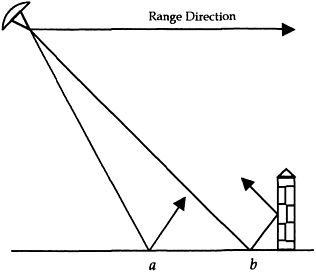247.
| [Cover] [Contents] [Index] |
Page 32
radar antenna. Smooth surfaces are specular, in that they act like a mirror and reflect the incident energy away from the sensor, resulting in extremely weak backscatter (Figure 1.18, point a). Normally, as the wavelength decreases, the surface appears rougher because smaller facets of the surface contribute to the scattering process, and thus stronger backscatter results. Likewise, as the wavelength increases, the surface tends to appear smoother. The strength of backscatter is also affected by the incidence angle. For a given wavelength, as the incidence angle increases, backscatter becomes weaker, and so the illuminated surface appears smoother. Some ground objects can behave like corner reflectors, which can reflect high energy back to the antenna, and cause bright spots on the radar image. Such phenomena often occurs in urban areas because energy can be returned by means of a ‘double-bounce’ from the corners of buildings (Figure 1.18, point b).
1.6.3.2 Surface conductivity
Highly conductive ground surfaces tend to have higher reflectivity than surfaces with lower conductivities. Water and metal are good conductors. As a result, radar backscatter will be sensitive to metal objects and to the presence of moisture in the illuminated target area, even though the amount of moisture may be small. In a radar image, metal objects such as railway tracks and metal bridges generally result in bright spots. Moisture also affects the depth of microwave energy penetration of the soil surface. If

Figure 1.18 Microwave energy impinging on a smooth surface (point a) at which energy is reflected away from the sensor, and exhibiting a ‘double bounce’ at point b when the reflected energy is reflected by a vertical wall.
| [Cover] [Contents] [Index] |
EAN: 2147483647
Pages: 354